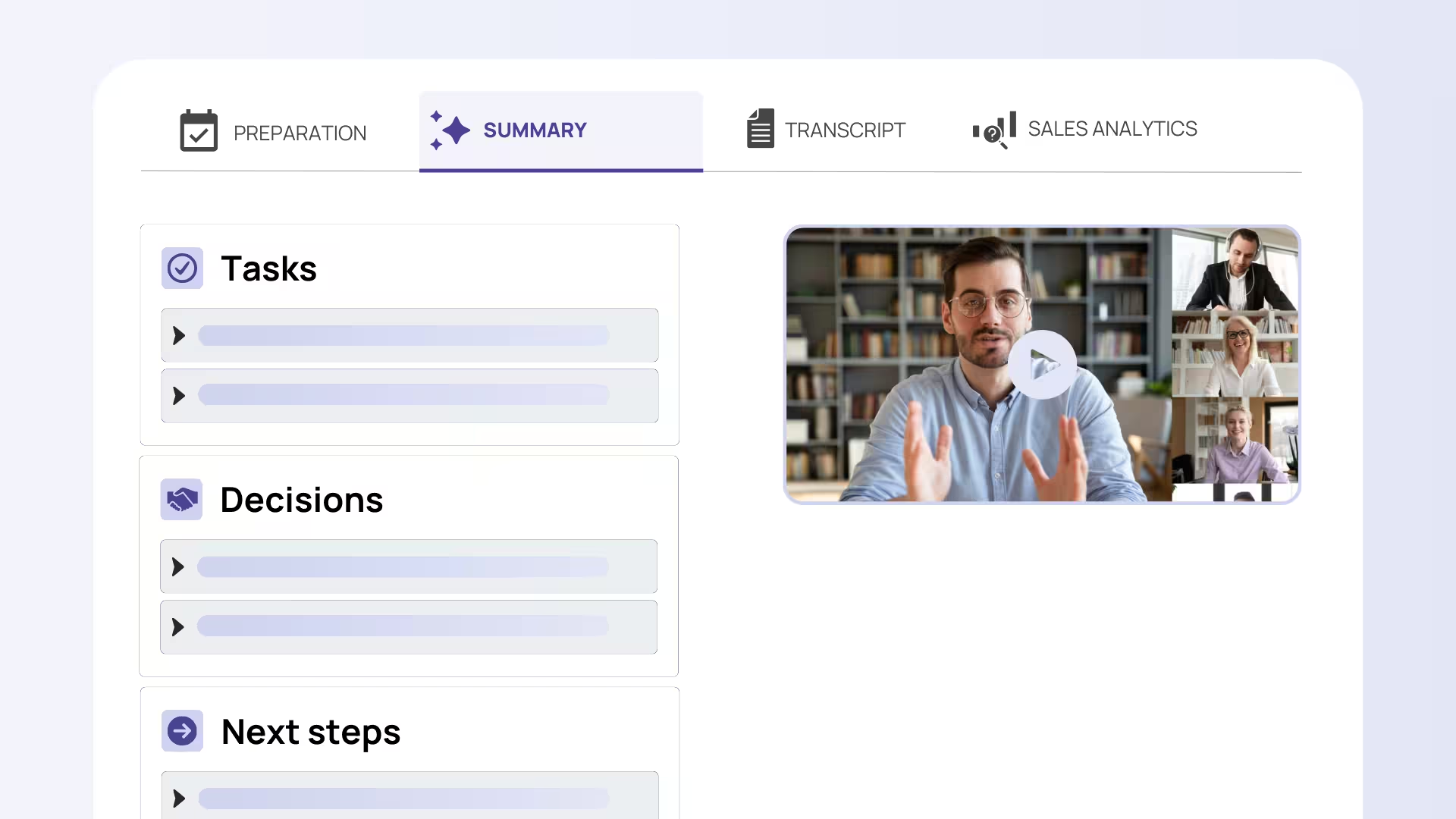Table of Contents
In today's fast-paced business world, time is precious – and nowhere is this more apparent than in meetings. While companies need increasing flexibility and agility to remain competitive in the market, they are often slowed down by lengthy decision-making processes. Endless discussions, postponed decisions, and inefficient coordination rounds cost not only time but also motivation and competitiveness.
The ability to make fast decisions in meetings has therefore become a crucial success factor. Teams that make decisions in a structured and efficient manner can respond more quickly to market changes, drive innovation, and complete their projects on schedule. This article shows you proven methods, practical techniques, and modern tools that can accelerate your decision-making processes while simultaneously improving the quality of your decisions.
Why Fast Decisions in Meetings Are Important
Importance for Agility and Competitiveness
Fast decision-making in meetings is more than just a nice-to-have – it's a strategic advantage. Companies like Spotify and Google have shown that market leaders distinguish themselves through their ability to react quickly to changes. When your team is capable of making important decisions promptly, you can identify and capitalize on new market opportunities earlier.
The speed of decision-making is particularly crucial in agile work environments. Projects can only achieve their planned milestones when decisions aren't discussed in meetings for weeks on end. Instead, fast, structured decision-making processes enable teams to focus on implementation and continuously learn and improve.
Innovation also thrives in an environment of fast decisions. When new ideas can be quickly evaluated and decisions made about whether to pursue them, more experiments emerge, creating more opportunities for breakthroughs. Delays in decision-making can lead to promising innovations arriving too late or being missed entirely.
Typical Problems with Slow Decision-Making Processes
Many teams know the problem: meetings drag on because no clear decisions are made. This leads not only to time loss but also to frustration among participants. Team members lose confidence in collaborative efficiency, and motivation noticeably decreases.
Slow decision-making processes bring additional risks. Projects fall behind schedule, budgets are exceeded, and customers become impatient. In extreme cases, important business opportunities can be completely missed because the competition acts faster. Studies show that teams that optimize their decision-making processes can reduce their project timelines by up to 30%.
Another problem is so-called "analysis paralysis" – the paralysis caused by too much analysis. When teams try to work through all possible scenarios before making a decision, they often lose sight of what's essential and miss the optimal timing for implementation.
Proven Methods and Techniques for Fast Decision-Making
Overview of Common Methods
There are numerous proven methods for fast decision-making in meetings that can be used depending on the situation and team size. Dot Voting is one of the most popular techniques: each participant receives a limited number of points (often as adhesive dots) that they can distribute among various options. This method is particularly effective for prioritizing ideas or features and quickly provides a clear picture of opinions.
The Fist to Five method enables quick assessment of team agreement. Each participant shows a number from zero (fist) to five with their fingers, where five means full agreement. This technique is particularly useful for quickly recognizing whether consensus is possible or if further discussion is needed.
Consensus decisions are useful when all participants must support the decision. This isn't about unanimity but about finding a solution that everyone can live with. Majority voting is the fastest method for clear yes/no questions but should only be used when acceptance by the minority is guaranteed.
Delegation of decisions to experts or smaller groups can save time, particularly with complex technical questions. It's important that delegation is clearly communicated and that decision-makers have the necessary competence and authority.
Practical Tips for Implementing Methods
The key to success lies in the consistent application of Timeboxing. Set clear time limits for each discussion and decision, and stick to them. A typical decision-making meeting should not last longer than 45 minutes, with 15 minutes planned for problem presentation, 20 minutes for discussion, and 10 minutes for decision-making.
Define roles in meetings clearly: A moderator guides the process, a note-taker records results, and decision-makers are named in advance. This clarity prevents confusion and significantly accelerates the process.
Formulate decision questions as precisely as possible. Instead of "How should we approach the project?" ask "Should we choose variant A or B for the next project phase?" The clearer the question, the faster the decision.

Role of Communication, Corporate Culture, and Technology
Communication as the Key to Fast Decisions
Open and transparent communication is the foundation for fast decision-making in meetings. When all participants can freely express their concerns and ideas, potential problems are identified early and solutions are found more quickly. Create an atmosphere where even controversial opinions are welcome – this leads to better decisions.
When disagreements arise, you should proceed systematically: let all viewpoints be heard, identify the core points of discussion, and look for compromise solutions. It often helps to steer the discussion toward objective criteria rather than debating personal preferences.
Influence of Corporate Culture
A trusting, error-friendly corporate culture significantly accelerates decision-making processes. When employees know they won't be punished for wrong decisions, they're more willing to make quick decisions and learn from the results. This psychological safety is a crucial factor for agile decision-making.
Hierarchical structures can slow down decision-making processes when every decision must be approved through multiple levels. Effective organizations create clear decision-making competencies and empower teams to make decisions independently within their area of responsibility.
Foster a culture of experimentation where fast decisions are seen as opportunities to learn. When teams know they can adjust their decisions based on new insights, they'll be more willing to decide faster.
Technological Support for Decision-Making Processes
Modern technology can significantly accelerate decision-making processes. Digital voting tools like Mentimeter or Poll Everywhere make it possible to quickly capture opinions even in large groups. These tools have become indispensable, especially in hybrid or virtual meetings.
Collaboration platforms like Miro or MURAL help visualize ideas and discuss them in a structured way. Real-time collaborative content editing makes decision-making processes more transparent and efficient.
AI-powered meeting assistants like Sally revolutionize the documentation and tracking of decisions. They automatically transcribe meetings, identify decisions and action items, and ensure nothing gets lost. This automated note-taking saves time and ensures all participants have the same information base.

Risks, Feedback, and Continuous Improvement in Fast Decisions
Risks of Fast Decisions and How to Minimize Them
Fast decisions carry the risk of poor decisions when important information is overlooked or insufficiently analyzed. However, this risk can be minimized through structured processes. Define clear decision criteria in advance and ensure all relevant information is available.
Long-term impacts on profitability can arise when fast decisions lead to frequent corrections. Here it helps to create a framework for "reversible" and "irreversible" decisions. Reversible decisions can be made quickly, while irreversible decisions require more consideration time.
Team dynamics can also suffer when team members feel overlooked in fast decisions. Ensure that all important stakeholders are included and their concerns are heard, even when the decision-making process should proceed quickly.
Feedback Mechanisms and Follow-up
Regular retrospectives are crucial for continuous improvement of your decision-making processes. Consciously plan time after important decisions to reflect: What went well? What could be better next time? These lessons learned meetings should run systematically and produce concrete improvement measures.
Feedback on decision quality should be gathered not only internally but also from external stakeholders. Customers, partners, or other departments can provide valuable insights into the impact of your decisions.
Best Practices with Examples from Practice
Spotify has developed the concept of "Squads" – small, autonomous teams that can make decisions quickly and independently. These teams work in short iterations and make decisions based on data and experiments. The result: rapid innovation and high adaptability to market changes.
Google uses the principle of "time-boxed" decisions, where a fixed time limit is set for each decision. After the time expires, a decision is made regardless of whether all questions are clarified. This method prevents endless discussions and forces teams to focus on essential points.
Agile startups show how important clear responsibilities and transparency are. Everyone knows who is responsible for which decisions, and all decisions are communicated transparently. This clarity reduces conflicts and accelerates processes.
Concrete Action Recommendations for Your Next Meetings
Start with thorough preparation: Define clear decision goals before each meeting and the criteria by which decisions will be made. Share this information with all participants in advance so they can prepare. Determine who takes which role: moderator, note-taker, and decision-makers should be named before the meeting.
Choose the right method for your situation: Dot Voting works well for prioritizations, Fist to Five for agreement queries, and consensus decisions for complex topics. Combine different techniques as needed and don't hesitate to switch methods during the meeting if another one better suits the current situation.
Invest in the right technology: Use digital tools for voting and collaboration, even in in-person meetings. An AI meeting assistant like Sally can help you automatically document and track decisions. Integration with your existing systems ensures that decisions seamlessly flow into your workflows.
Create an open communication culture where all participants can express their opinions. Encourage your team to also voice uncomfortable truths and engage in controversial discussions. At the same time, build trust by treating mistakes as learning opportunities rather than occasions for blame.
Don't forget the follow-up: Regularly gather feedback on your decision-making processes and conduct retrospectives. Document what worked well and what can be improved. This continuous improvement is the key to long-term successful decision-making processes

Conclusion – Fast Decision-Making as a Success Factor
Fast decision-making in meetings is far more than just time savings – it's a strategic advantage that can determine success or failure in today's business world. The combination of proven methods, open communication, supporting technology, and a learning-oriented culture creates the foundation for effective decision-making processes.
The key lies in a holistic approach: structured methods like Dot Voting or Fist to Five are only successful when used in an environment that promotes and rewards fast decisions. Modern tools can support these processes, but they don't replace the need for clear communication and defined responsibilities.
Start small and experiment with the presented methods in your next meetings. Gather experience, collect feedback, and continuously adapt your processes. The ability to make decisions quickly and effectively will make your team more agile and help you succeed in an increasingly fast-paced business world. The time you invest in optimizing your decision-making processes will pay off many times over – in the form of better results, more motivated teams, and sustainable competitive advantages.
Additional: Brief Introduction to the Tool "Sally"
Sally is a GDPR-compliant AI meeting assistant specifically developed to support and document decision-making processes in meetings. The tool automatically joins your meetings in Zoom, Google Meet, or Microsoft Teams and creates detailed transcriptions and summaries.
Sally is particularly valuable for documenting decisions and tracking action items. The tool automatically recognizes when decisions are made and creates structured minutes that can be immediately shared with your preferred tools. With integration into over 8,000 platforms, including common CRM and project management tools, Sally ensures that no important decision is lost and all participants are always up to date.

Try meeting transcription now!
Experience how effortless meeting notes can be – try Sally free for 4 weeks.
Test NowOr: Arrange a Demo Appointment

.avif)



